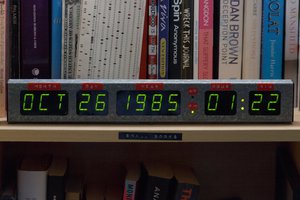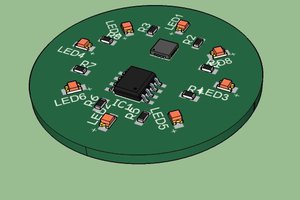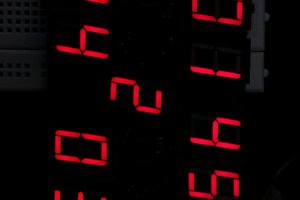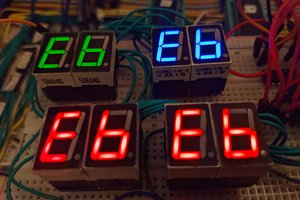7 Segment Display Module using DM9368N
Handy 7 seg module that crams two DM9368N and two digits onto a single board that I can plug in on my breadboards.
Handy 7 seg module that crams two DM9368N and two digits onto a single board that I can plug in on my breadboards.
To make the experience fit your profile, pick a username and tell us what interests you.
We found and based on your interests.
|
JPEG Image - 3.45 MB - 03/13/2021 at 21:38 |
|
|
|
JPEG Image - 2.78 MB - 03/13/2021 at 21:38 |
|
|
|
JPEG Image - 2.69 MB - 03/13/2021 at 21:38 |
|
|
I'm about to update the successor project https://hackaday.io/project/178227-7-segment-module-using-pic16f18446 to cover the latest variant of that board.
The DM9368 is a classic part but at £5 each and the counterfeiting I'm not interested. The PIC costs about £1 and I need only one PIC for the pair of digits whereas the DM9368 needs one per digit. So it's £10 vs £2 for a much more appealing result.
A big advandage fo the use the PIC is that I have been able to build a module that's no bigger in real estate than the two seven sebment displays themselves.
My advice is to abandon attempts to use the DM9368 at al for this kind of application
I doubt I'll post here again.
You can see the progression in the design below. On the right is the DM9368 model and the two on the left are the PIC models.
The successor can be seen here https://hackaday.io/project/178227-7-segment-module-using-pic16f18446
and also .. https://github.com/Johnlon/SevenSegmentModule
This project replaces the use of two classic DM9368 display drivers with a single 8 bit microcontroller.
The microcontroller being a current part is easy to obtain and super cheap, and now that I've figured out how to use Microchip's IDE and toolkit I have already written the program code and tried it with their simulator.
Hoping the chips will arrive in a couple of days. Microchip has crazy lead times on delivery.
Keep an eye on the new project.
Despite my decision to rebuild this board using a microcontroller instead, I thought some images of the final product as it exists would be in order.
The bare board
I switched to long pins so there's clearance under the device for wiring.
This version uses headers with male pins at both ends. In the next variant I'll use female headers with long pins and mount from the top of the board so that I can put jumper wires into the receptacles. Or, perhaps male/male jumpers with long pins at both sides? Either way it will allow for top connection as an option.
So this project works fine BUT all but two of the driver IC's I have turned out to be fakes.
I've done a bit of research and it looks like I can achieve pretty much the same thing with a microcontroller.
I've ordered a few PIC16F18446-I/P and wil redesign the board for these. I'll use 8 inputs and 9 outputs. pins.
7 of the outputs will drive segments and the 8th and 9th outputs will select which of the two digits will be lit.
The GPIO outputs can handle plenty of current but I'll be limiting that with a resistor anyway. I can connect the digit select output pin to the common cathode of one digits so when the digit select pin is low then it will be enabled and the digit lit.
The data sheet is massive and I've never used a microcontroller so there is an excellant chance that I've misunderstood this device.
Datasheet page 629 has the electrical specs https://ww1.microchip.com/downloads/en/DeviceDoc/40001985B.pdf
If this approach works then it's actually a singe chip solution I think unlike the current design.
The other advantage is that the PIC16F18446 device is really cheap and available. I ordered direct from the manufacturer but there a deilivery cost so I ordered 5 or 6 of them; enough for 12 digits.
The DM9368driver is a constant current device and drives the LEDs at 20mA. Looking at the datasheet I'm thinking that's 20mA per segment which is 140mA per digit.
If I then include say 8 of these in my CPU I end up burning more than an Amp on LED's - a whole Amp!!
That's a bit rich for my needs (my SPAM-1 CPU), I don't want to burn that much juice.
This is a common cathode driver IC and in the PCB that I have on order I left a space for a resistor on the between the LED cathode and ground to limt the current.
I as a bit concerned at this approach because if one want's the segments to light up consistenty as the digits change then you really ought to have one resistor per segment. But that's a lot of work and space so I figured I'd live with a horrible flickering if needs be.
Well I just put it on breadboard and tried a driving the LEDs with the cathode directly attached to ground. Wow are they bright!
I then tried a 1K resistor on the cathode and sure enough they are a whole bunch dimmer.
The driver IC high is about 3.1v and the resistor is dropping about 1.4v with the LED dropping 1.7v forward. So with 1K at 1.4v I'm using 1.4mA for the whole device rather than 140mA. The display is defnitely not 100x dimmer.
I also tried changing how many segments were lit and was pleased to see that the brightness didn't seem to be that sensistive to the number lit. I am guessing this is because at this low forward current perhaps they are really efficient. With all 7 segments on I'll get about 0.2mA per segment and perhaps the difference between 0.2mA and 1mA at this current range is irrelevant.
I looked at a datasheet but it's graphs of intensity vs current didn't go below 1mA
Anyway looking forward to the board arriving, but a bit worried because I realised last night that I hadn't been careful enough when setting out the PCB and the pin headers to the breadboard aren't as perfectly alligned as I intended. Fingers crossed.
Board is in production with PCB firm.
Looking forward to doing some soldering!
Create an account to leave a comment. Already have an account? Log In.
@Dave's Dev Lab is this basically the same device..
ATF16V8B-15PU
Cheaper than the microcontrollers direct from microchip
yes that is the exact model that i have! they can be flashed with the generic TL866 usb based eeprom programmer and there is a free compiler called WinCuPL (for windows only).
@Dave's Dev Lab That's for the pointers.
The microcontrollers area on their way in the post so I feel a bit committed to that approach now.
But it will be interesting to compare the various approaches. I suspect the gal approach is cheaper is you can get 10 at a time from China but risk more counterfeits. I got stitched up for 10 of those DM chips. Also your gal approach is definitely simpler in the programming respect.
It of also ironic that each of these displayed to build will contain a microcontroller that is orders of magnitude more capable as a general purpose computing device than my TTL Computer! So in that respect too the GAL is less galling.
@John Lonergan - no worries! i was mainly pointing out i came to the same conclusion as you did! i was lucky to pick up about 5k 16V8's at surplus auction a few years ago, so i have plenty of stock to play with for all kinds of solutions! https://hackaday.io/project/158510-ddl4-cpu
5 thousand!!!!
Yeah ok . Defo the right solution!!
It was the cost and fake risk that put me off the GAL. Wow
yeah i got an entire pallet for $200. ended up with a ton of stuff including about 5k 7-seg displays, and 5k 80c52 chips in additon to the 16v8's
great looking design! i also found that the DM9368N was difficult to purchase and looked for an alternative. i ended up going with a PAL 16V8 to do the decoding. i documented my version if you are interested -
https://hackaday.io/project/163274-4-bit-full-hex-decoder
https://hackaday.io/project/164540-8-bit-hex-decoder
Become a member to follow this project and never miss any updates

 Stephen Holdaway
Stephen Holdaway
 Luc
Luc

 John Lonergan
John Lonergan
What on earth are you planning to do with them? Crash the market for them on Ebay or something?